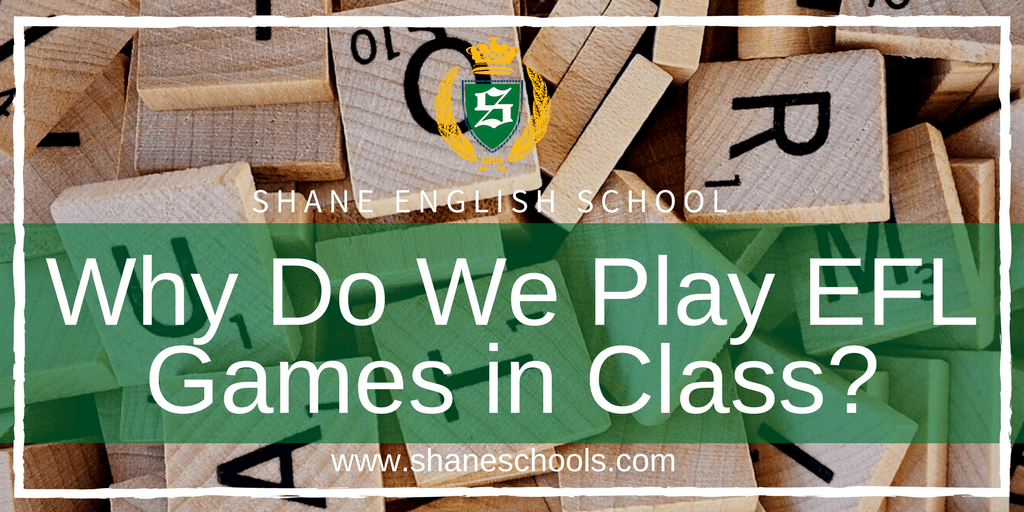EFL games play a huge part in students’ educational journeys. Many young EFL learners spend a lot of time every day in school and then attend additional classes in the evening. Therefore, when they come to us, and in order to keep them coming back to us, we need to make our lessons fun. This is one of the main reasons we play games in class, but it is not the only one. So what are some of the other reasons?
Games can do any of the following:
- Motivate the children to participate and engage in class
- Help to create fluency by making speaking fun
- Aid accuracy
- Check understanding when used in an appropriate context
- Give lots and lots of language practice to the students
- ‘Trick’ the students into learning passively
- Provide pace to the lesson
- Burn energy in a lively class
- Create competition, which is a very important motivating factor in young EFL learners
These are the main reasons why we play games in class, but how do we integrate them into our plans?
When Do We Play EFL Games?
With so much work to get through in so little time, it can be difficult to see where we can fit games into our lesson plans. We can use different types of games at different stages, to maximize fun and learning, and to keep the pace of the lesson quick.
Games / fun activities should always be used in the following stages:
- Warmer: This should be a whole class activity, and is aimed at waking up the students’ brains. It is a good opportunity for phonics review.
- Practice: We use games here to maximise the spoken repetition of new language taught, to help language retention. These games should encourage lots of drilling and chanting.
- Follow-up (in review and main stage): These games should give the students opportunity to talk to each other, using the language they have just learned. Pair work, mingling and survey games work well here.
- Change of pace: Games used here could use the target language from today’s lesson, but do not have to. They should be lively and energetic, getting students out of their seats, to break up the monotony of the slower- paced bookwork during the second half of lessons.
- Reading and writing (after TPR and blending): These are games that should encourage the application and use of the phonics practiced in the TPR and blending stages.
- Fun activity (Funtivity): These are just fun, quick games to send the students home smiling, and should take no more than three or four minutes. They do not have to be language based, but it’s better if they are.
For more on the best times to do what kind of game, you can read more about the PPP method we use at Shane English School.
How to Plan Good Games
So we now know why and when we play games, but how do we know what makes a good game? Do we just let the students loose with a sticky ball and white board? A baseball bat, rubber chicken, and some vague instructions? How effective would this be? Below are some of the main points to consider when planning an effective ESL/EFL game.
- Whole class participation: A basic rule of thumb for a good game is that it includes all students, not just two or three. If the focus of the game is on just one pair or group of students, make sure the rest have a task to keep them occupied, for example building a tower of blocks or completing some other rudimentary task. This will stop the students getting bored.
- Setup: All games need to be set up clearly. The best way to do this is to demo the game with a TA or a capable student. Keep all instructions to a minimum and make sure to be aware of the language level of your students.
- Safety: Royal Rumble Last Man Standing King of the Ring Flashcard Wrestling may be a fun game, but there won’t be many students left to play it next term. Remember that you are responsible for the safety of the children in your class. All games MUST be safe to play. If in doubt, ask your TA, school manager, or DLM as to what is and is not acceptable.
- Relevance to target language: Games are fun, but they also must have a language point. Make sure the students are always using language in your games, meaningfully and in a real context whenever possible.
Besides these four main points, there are also other points to consider, such as:
- Fun, classroom dynamics, resources, suitability to age, gender, competitiveness, scoring system, variety, interaction pattern (student-student in follow-up, teacher-student or student-teacher in practice), fairness, challenge, opportunities for success, timing, opportunities for praise, and enthusiasm (student and teacher).
When thinking about what games you are going to use in your lesson, think about all the points above and remember to ask yourself the following three questions:
- Why am I going to play this game?
- When am I going to play this game?
- How am I going to make the students aware of how to play this game?
In doing this you give yourself, and your students, the greatest chance of participating in a fun, fast-paced, educational lesson.
What role do games play in your class? Let us know on Twitter!
A version of this article originally appeared in Shane English Schools Taiwan’s Teaching English to Young Learners (TEYL) program, which is part of all new teachers’ orientation.

We're hiring!
With schools around the world, Shane English School always has exciting new opportunities to offer.


